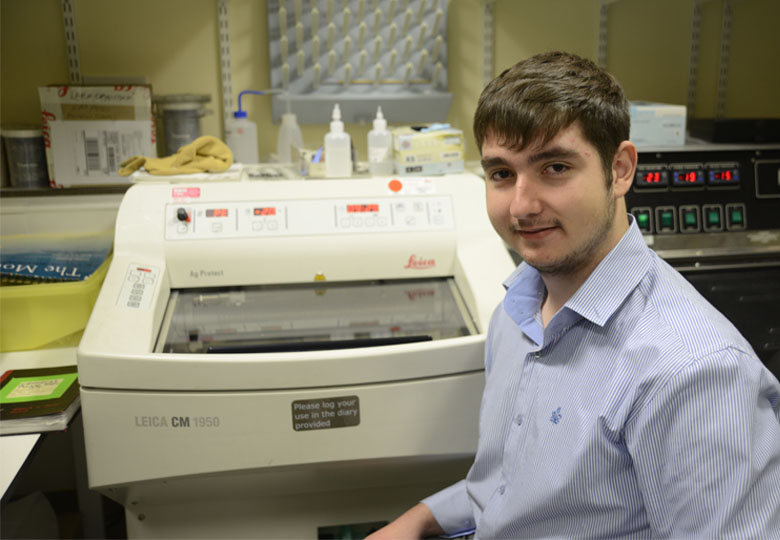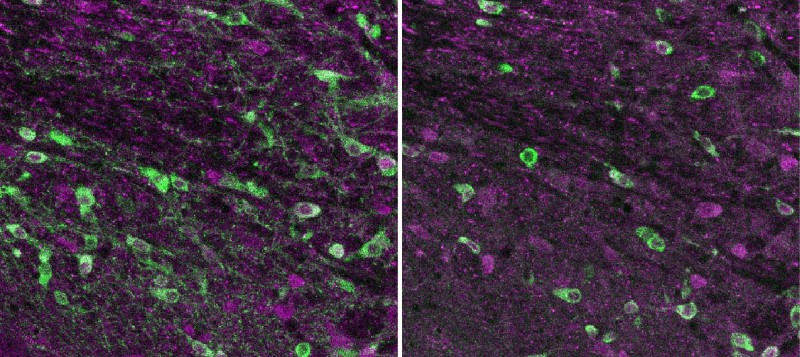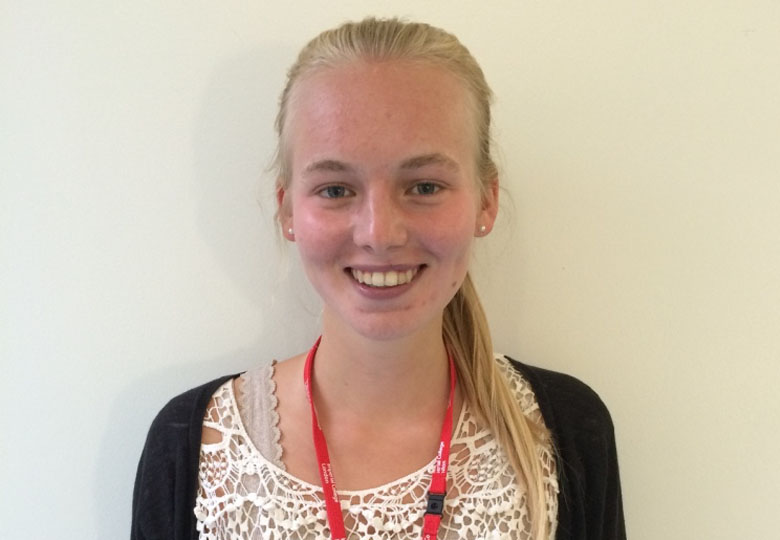By Helen Figueira
September 4, 2015
Time to read: 7 minutes
This summer, two A-level students spent time in the laboratories and offices of the MRC’s Clinical Sciences Centre (CSC) at Imperial College. Vlad Pasca got stuck into basic research with a four week project that involved hunting for neurons in the brain. His work here was supported by the Nuffield Foundation’s Research Placement scheme. Olivia Dawson spent a week exploring the plethora of career opportunities that are on offer in the science sector, from basic research to grants and funding to communications. In these personal accounts, the students describe their time at the CSC and whether it’s encouraged them to pursue careers in science.

Vlad Pasca
The nerve cells in our brains, the neurons, communicate with each other by releasing small molecules called neurotransmitters. Dopamine is one such neurotransmitter, and it’s vital because it’s produced in a region of the brain that sends messages to other parts of the brain that control movement, memory and attention. People with Parkinson’s Disease struggle to control their movements because their dopamine-producing neurons die. If scientists could find a way to stimulate the neurons, or keep them alive, they may one day be able to raise the levels of dopamine in a patient’s brain. But such a treatment is a long way off.
Although scientists know that the neurons are regulated by another neurotransmitter, called ‘GABA’, they do not yet understand exactly how this happens. My four week research project aimed to find out how the neurons that produce dopamine and GABA are connected to each other within a central region of the brain, called the ‘midbrain’. Scientists know that the neurons that release GABA cluster together in sub-groups, however it is difficult to identify these sub-groups.
When I was first told about my project I was overwhelmed. I was previously unaware that this type of research was going on and was excited to begin. I did a lot of background research on how to label neurons with fluorescent molecules so that they can easily be identified. I frequently clarified points with my supervisor, Eleanor Paul who is a PhD student in the CSC’s Neurophysiology group, and asked about the possible applications of the research.
I studied the brains of mice. To cut slices of brain tissue, I used a fine cutting machine called a Cryostat. Each slice is less than one tenth of a millimetre thick and the Cryostat keeps the brain tissue at -20°C to protect it from damage while.
I then poured antibodies onto the tissue. Antibodies are proteins that normally bind to the bacteria and viruses that enter our body, and mark them for destruction by our immune system. I used antibodies that bind to a protein called Parvalbumin, and a neuropeptide called Somatostatin, which we thought might be found in some of the subgroups of GABA neurons. I also added a second set of antibodies, which could bind to the first ones and, when bound together, the antibodies could make the neurons containing Parvalbumin and Somatostatin fluoresce under the microscope, and hopefully make them easy to spot.
“It is great to think that my results could influence future research”
I was the first person to explore whether it is possible to use Parvalbumin and Somatostatin to identify GABA neurons in this part of the brain. For this reason my work will need repetition and refinement. My early results show that the method can be used to identify subgroups of dopamine and GABA neurons, so it certainly has potential.

Identifying groups of neurons in this way could help scientists to gain a more detailed understanding of the structure of the midbrain. This could ultimately help in the hunt for treatments for conditions such as Parkinson’s Disease.
It is great to think that my results could influence future research in this way. The project has been fascinating and rewarding, and has encouraged me to go into science.

Olivia Dawson
I am a Year 12 student eager to study science, and am keen to learn about what scientists do on a daily basis. The MRC’s Clinical Sciences Centre seemed the perfect place to do a work experience placement because it is a cutting edge research lab where I could meet scientists at the top of their field, and find out about their work.
I haven’t had much exposure to a research lab before, so this provided an insightful experience. I spent one morning working with the CSC’S Redox Metabolism group. This research group uses the fruit fly Drosophila melanogaster as a model organism to investigate how to improve health and life span in people. My initial question was, why do the researchers use this specific type of fly? I discovered that Drosophila melanogaster actually share a large percentage of our DNA, which means that conclusions drawn from looking at the flies can be extrapolated to the ageing human population.
“The amount of detail you could see was just incredible”
It’s easier to study ageing in fruit flies than in people, because the flies have a short life cycle and grow old within a number of days. The flies are also cheap to maintain and easy to feed with sugars and starch. The most fascinating part of this session was observing the flies under a microscope; the amount of detail you could see was just incredible.
Later that afternoon I spent time with the CSC’s Mass Sepctrometry and Proteomics Facility. I especially enjoyed learning about the analytical techniques, such as mass spectrometry, which is used to analyse the structures and functions of proteins. I’ve had brief exposure to the purpose and uses of mass spectrometry through my chemistry studies at school, but have never really understood how it’s used in real world situations, such as in airport security. I also found it fascinating to understand just how important machines like these really are in science, as analysing the chemical and biochemical properties of proteins is simply impossible without the assistance of technology.
Something I hadn’t particularly considered before my time at the CSC was the non-scientific side of a life in science, for example grants and funding from the likes of the Wellcome Trust, and how essential it is. Neither had I appreciated the need for communication in science, which I soon found to be absolutely crucial. Science is all about sharing ideas by attending conferences, publishing papers and engaging the public through workshops and events.
“I found it fascinating to understand just how important machines like these really are in science”
I was astounded by the diversity of research that takes place at the CSC. My week here has highlighted the variety of opportunities that are available in science when I leave school. It has taught me a lot about the working environment of a research centre, and I am now desperate to experience and learn more.
Find out more:
Deborah Oakley
Science Communications Officer
MRC Clinical Sciences Centre
T: 0208 383 3791
M: 07711 016942
E: